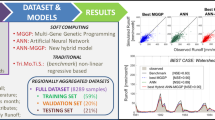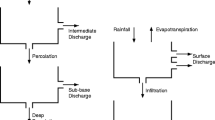Abstract
Hydrologic processes are complex, non-linear, and distributed within a watershed both spatially and temporally. One such complex pervasive process is soil erosion. This problem is usually approached directly by considering the sediment yield. Most of the hydrologic models developed and used earlier in sediment yield modeling were lumped and had no provision for including spatial and temporal variability of the terrain and climate attributes. This study investigates the suitability of a recent evolutionary technique, genetic programming (GP), in estimating sediment yield considering various meteorological and geographic features of a basin. The Arno River basin in Italy, which is prone to frequent floods, has been chosen as case study to demonstrate the GP approach. The results of the present study show that GP can efficiently capture the trend of sediment yield, even with a small set of data. The major advantage of the GP analysis is that it generates simple parsimonious expression offering some possible interpretations to the underlying process.




Similar content being viewed by others
References
Aytek A, Kisi O (2008) A genetic programming approach to suspended sediment modeling. J Hydrol 351:288–298
Babovic V, Keijzer M (2000) Genetic programming as model induction engine. J Hydroinform 2(1):35–60 ISSN: 1464-7141
Babovic V, Keijzer M, Aguilera DR, Harrington J (2001) An evolutionary approach to knowledge induction: genetic programming in Hydraulic Engineering. In: Phelps D, Sehlke G (eds) World Water and Environmental Resources Congress 2001, ASCE, Orlando, Florida, USA, 20–24 May
Baiocco F, Bazzoffi P, Jacomini C, Munafò M, Napoli R, Piva F, Pugliese A, Vittori E (2003) GIS integration of PISA model for assessing net soil erosion trends and off-farm risk from existing databases. Agricultural impacts on soil erosion and soil biodiversity: developing indicators for policy analysis. In: Proceeding of OECD expert meeting Rome, pp 273–282, 25–28 March
Bazzoffi P, van Rompaey A (2003) PISA model to assess off-farm sediment flow indicator at watershed scale in Italy. Agricultural impacts on soil erosion and soil biodiversity: developing indicators for policy analysis. In: Proceeding of OECD expert meeting Rome, pp 263–272, 25–28 March
Borah DK, Krug EC, Yoder D (2008) Watershed sediment yield. In: Garcia MH (ed) Sedimentation engineering: processes, measurement, modeling, and practice. In: ASCE manuals and reports on engineering practice no 110, ASCE, Virginia pp 827–858
Caporali E, Rinaldi M, Casagli N (2005) The arno river floods. Giornale di Geologia Applicata 1:177–192. doi:10.1474/GGA.2005-01.0-18.0018 ISSN: 1825-6635
de Roo APJ, Wesseling CG, Ritsema CJ (1996) LISEM: a single event physically-based hydrologic and soil erosion model for drainage basins: I Theory, input and output. Hydrol Process 10(8):1107–1117
de Vente J, Poesen J (2005) Predicting soil erosion and sediment yield at the basin scale: scale issues and semi-quantitative models. Earth-Sci Rev 71:95–125
de Vente J, Poesen J, Verstraeten G (2005) The application of semi-quantitative methods and reservoir sedimentation rates for the prediction of basin sediment yield in Spain. J Hydrol 305:63–86 Elsevier
de Vente J, Poesen J, Bazzoffi P, Van Rompaey A, Verstraeten G (2006) Predicting catchment sediment yield in mediterranean environments: the importance of sediment sources and connectivity in Italian drainage basins. Earth Surf Process Landf 31:1017–1034
Dorado J, Rabunal JR, Puertas J, Santos A, Rivero D (2002) Prediction and modelling of the flow of a typical urban basin through genetic programming. In: Cagnoni S, Gottlieb J, Hart E, Middendorf M, Raidl GR (eds) Proceedings of the EvoWorkshops 2002, pp 190–201. Kinsale, April 3–4
Drunpob A, Chang NB, Beaman M (2005) Stream flowrate prediction using genetic programming model in a semi-arid coastal watershed. In: Walton R (ed) World water and environmental resources congress 2005, ASCE, Anchorage, 15–19 May
Flanagan DC, Ascough JC II, Nicks AD, Nearing MA, Lafle JM (1995) Overview of the WEPP erosion prediction model. In: Flanagan DC, Nearing MA (eds) USDA-water erosion prediction project Hillslope profile and watershed model documentation. USDA, Indiana, pp 1.1–1.12
Foster GR, Flanagan DC, Nearing MA, Lane LJ, Risse LM, Finker SC (1995) Hillslope erosion component. In: Flanagan DC, Nearing MA (eds) USDA-water erosion prediction project Hillslope profile and watershed model documentation. USDA, Indiana, pp 11.1–11.12
Garg V, Jothiprakash V (2010) Modeling the time variation of reservoir trap efficiency. J Hydrol Eng (ASCE) 15(12):1001–1015
Harris EL, Babovic V, Falconer RA (2003) Velocity prediction in compound channels with vegetated floodplains using genetic programming. Int J River Basin Manag 1(2):117–123
Jakeman AJ, Green TR, Beavis SG, Zhang L, Dietrich CR, Crapper PF (1999) Modelling upland and in-stream erosion, sediment and phosphorus transport in a large catchment. Hydrol Process 13(5):745–752
Jayawardena AW, Muttil N, Lee JHW (2006) Comparative analysis of data-driven and GIS-based conceptual rainfall-runoff model. J Hydrol Eng 11(1):1–11
Khu ST, Liong SY, Babovic V, Madsen H, Muttil N (2001) Genetic programming and its application in real-time runoff forecast. J Am Water Resour As 37(2):439–451
Koza JR (1992) Genetic programming: on the programming of computers by means of natural selection. The MIT Press, Cambridge
Koza JR, Keane MA, Streeter MJ, Mydlowec W, Yu J, Lanza G (2005) Genetic programming IV: routine human-competitive machine intelligence. Springer, Berlin
Liong SY, Gautam TR, Khu ST, Babovic V, Keijzer M, Muttil N (2002) Genetic programming: a new paradigm in rainfall-runoff modeling. J Am Water Resour As 38(3):705–718
MacArthur RC, Neill CR, Hall BR, Galay VJ, Shvidchenko AB (2008) Overview of sedimentation engineering. In: Garcia MH (ed) Sedimentation engineering: processes, measurement, modeling, and practice. ASCE manuals and reports on engineering practice no 110. ASCE, Virginia, USA, pp 1–20
Makkeasorn A, Chang N-B (2007) Short-term stream flow forecasting with the aid of global climate change indices. Environ Inform Arch 5:440–454
Merritt WS, Letcher RA, Jakeman AJ (2003) A review of erosion and sediment transport models. Environ Model Softw 18(8–9):761–799
Morgan RPC, Quinton JN, Smith RE, Govers G, Poesen J, Auerswald K, Chisci G, Torri D, Styczen ME (1998) The European soil erosion model (EUROSEM): a dynamic approach for predicting sediment transport from fields and small catchments. Earth Surf Proc Landf 23:527–544
Muttil N, Liong SY (2001) Improving runoff forecasting by input variable selection in genetic programming. In: Phelps D, Sehlke G (eds) World water and environmental resources congress 2001. Orlando, 20–24 May
Nash JE, Sutcliffe JV (1970) River flow forecasting through conceptual models. 1. A discussion of principles. J Hydrol 10:282–290
Osterkamp WR, Toy TJ (1997) Geomorphic considerations for erosion prediction. Environ Geol 29(3/4):152–157
Ownegh M, Nohtani M (2004) Relationship d in Kashidar Watershed, Golestan Province, Iran. Proceedings of 13th international soil conservation organisation conference (ISCO-2004), Brisbane, July 2004, paper no 999
Parasuraman K, Elshorbagy A, Carey SK (2007) Modelling the dynamics of the evapotranspiration process using genetic programming. Hydrol Sci J 52(3):563–578
Renard KG, Foster GR, Weesies GA, McCool DK, Yoder DC (1997) Predicting soil erosion by water: a guide to conservation planning with the revised universal soil loss equation (RUSLE), Agriculture handbook no 703. USDA, Washington
Savic DA, Walter GA, Davidson JW (1999) A genetic programming approach to rainfall-runoff modelling. Water Resour Manag 13:219–231
Singh, AK, Deo MC, Sanil Kumar V (2007) Neural network—genetic programming for sediment transport. J Marit Eng 160(MA3):113–119. The Institution of Civil Engineers, London, ISSN: 1741-7597
Sivapragasam C, Vincent P, Vasudevan G (2007) Genetic programming model for forecast of short and noisy data. Hydrol Process 21:266–272
Sivapragasam C, Maheswaran R, Venkatesh V (2008) Genetic programming approach for flood routing in natural channels. Hydrol Process 22:623–628
Wasson RJ (2002) What approach to the modelling of catchment scale erosion and sediment transport should be adopted? In: Summer W, Walling DE (eds) Modelling erosion, sediment transport and sediment yield, IHP-VI technical documents in hydrology. UNESCO, Paris, pp 1–11
Whigham PA, Crapper PF (2001) Modelling rainfall-runoff using genetic programming. Math Comput Model 33:707–721
Wischmeier WH, Smith DD (1965) Predicting rainfall-erosion losses from cropland east of the rock mountains. Agricultural handbook no 282. USDA, Washington, DC
Wischmeier WH, Smith DD (1978) Predicting rainfall-erosion losses: a guide to conservation planning. Agriculture handbook no 537. USDA, Washington
Acknowledgments
This work used software developed under the Talent Project N° 9800463 entitled “Data to Knowledge—D2K” funded by the Danish Technical Research Council (STVF) and the Danish Hydraulic Institute (DHI). The author gratefully acknowledges the anonymous reviewers and editors for their valuable reviews and suggestions.
Author information
Authors and Affiliations
Corresponding author
Rights and permissions
About this article
Cite this article
Garg, V. Modeling catchment sediment yield: a genetic programming approach. Nat Hazards 70, 39–50 (2014). https://doi.org/10.1007/s11069-011-0014-3
Received:
Accepted:
Published:
Issue Date:
DOI: https://doi.org/10.1007/s11069-011-0014-3




